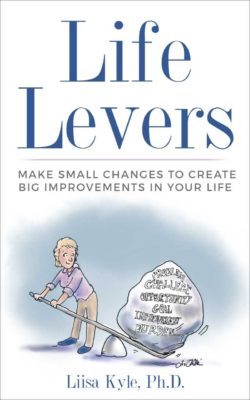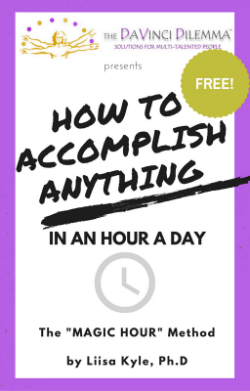
By Dennis Murphy [Public domain], from Wikimedia Commons
Here are Five Ways a Timer Can Help You and Your Talents:
1. Overcome procrastination. (In other words: Help you Get Started).
The next time you find yourself procrastinating, set your timer for ten minutes. Commit to doing as much as possible during those ten minutes. Whatever you get done is enough.
Bonus #1: You will also avoid distractions. Somehow, when the timer is ticking, it helps foster focus.
Bonus #2: You will be surprised how much you can accomplished when you give yourself a ten minute time limit. There’s something about the time pressure that motivates you to you get things done.
Bonus #3: Odds are, when the timer goes off, you won’t want to stop. A body in motion stays in motion – sometimes we just need a little nudge to break out of our inertia.
2. Improving the quality of your work. (“Work” meaning whatever it is you’re doing – your job, your talents, your domestic chores or something else).
Want to get things done? Clear one hour and select the task you’d like to do. Commit to completing fifty focused, uninterrupted minutes on your task. Before you begin, take what steps are necessary to ensure you won’t be interrupted — for example, close the door, unplug the phone, disable your internet connection, etc. Now, set your timer for fifty minutes and begin.
If, while you’re working, you think of something critical that needs doing, write it down as a reminder so you can do it AFTER the fifty minutes has passed. When the timer goes, set it to ten minutes. During this period, do whatever would be a fitting reward — walk around the block, call a friend, check your email, snuggle your pet, stretch your body — whatever you like.
Using this method, you will find that your work is more focused and of higher quality.
Bonus #1: Built-in rewards for a job well done. This is highly motivating.
Bonus #2: Using this technique multiple times a day or week can increase your productivity tremendously.
3. Establish a new (helpful) habit.
Think about an action that would improve your life if you did more of it – especially on a daily basis. Something that you really, really want to do more. Something you know will be very beneficial to your well-being. For example, walking, exercising, writing, practicing an instrument, journalling, spending time with your kids, etc. Now think about your ideal goal: let’s use the example of walking at least 30 minutes a day, at least five days a week.
Now: think about an initial commitment that you can EASILY achieve. In our example, let’s say we’ll walk five minutes a day, at least three times a week.
What’s that you say? How can a five minute walk possibly make any difference to your life? It’s not the AMOUNT of the activity that’s important. What’s important is ESTABLISHING THE HABIT.
Now: honor your initial commitment. Using your timer to keep you honest, walk five minutes a day, at least three times this week. Keep track. You can walk more if you’d like. Doesn’t matter. What does matter is that you walk AT LEAST five minutes, at least three times during the week.
If you do walk at least five minutes at least three days a week, congratulations! You’re well on your way to establishing your new habit.
If you find, at the end of the week, that you didn’t keep your commitment, don’t beat yourself up. Simply ask: “Hmm, why didn’t I do this?” Either the new habit isn’t really something you’d like to establish and/or you’re experiencing [resistance that needs to be dealt with].
Once you are successful in establishing your initial commitment (let’s say a month of walking at least five minutes, at least three times a week), you can increase the amount of time per session. Note: better to take your time doing this, rather than trying to do too much, too fast which will lead to breaking your commitments, frustration and failure.
Here’s a sample schedule to establish a lifelong habit:
Month One: Walk at least 5 minutes at least 3 times a week.
Month Two: Walk at least 10 minutes at least 3 times a week.
Month Three: Walk at least 15 minutes at least 3 times a week.
Month Four: Walk at least 20 minutes at least 3 times a week.
Month Five: Walk at least 25 minutes at least 3 times a week.
Month Six: Walk at least 30 minutes at least 3 times a week.
Month Seven: Walk at least 30 minutes at least 4 times a week.
Month Eight: Walk at least 30 minutes at least 5 times a week.
4. Meditate.
Especially for those new to meditation or impatient with it, the timer is invaluable. According to Yougey Mingyur Rinphoche, it is best to meditate for short periods of time (like 2- 3 minutes) throughout the day.
Whenever you think about it – once an hour if you’d like – set your timer for two minutes, sit upright and clear your mind.
Many Bonuses: studies show that people who meditate – even beginners—are healthier, happier and less stressed than those who don’t.
5. Beat unhealthy cravings
If there’s something you are trying to do less of – snacking, surfing the internet, watching television, smoking, drinking alcohol, etc. – your timer can help. Let’s use the example of snacking.
First, generate a list of healthy things you’d rather do for fifteen minutes. In our case, let’s say, instead of snacking, we’d rather walk around the block, listen to some music, paint, knit, call a friend to chat, have a bath, cuddle your pet, read a good book or mediate.
Now, when the craving hits, set your timer for fifteen minutes and commit to not give into your craving for that period of time. Then, refer to your list and do the first thing that jumps out at you.
Example: I find myself wandering into the kitchen, seeking something/anything to munch. “Oh no!” I say. “This is a craving.” I deftly set my timer for 15 minutes and quickly refer to my List of Alternative Activities. “Around the block we go!”
Bonus #1: you will be doing more of what you prefer to do
Bonus #2: you are likely to find that, fifteen minutes later, not only has the craving passed, you’ve completely forgotten about it.
***
 Want more tips and techniques on getting things done? Check out my book YOU CAN GET IT DONE: Choose What to do, Plan, Start, Stay on Track, Overcome Obstacles, and Finish
Want more tips and techniques on getting things done? Check out my book YOU CAN GET IT DONE: Choose What to do, Plan, Start, Stay on Track, Overcome Obstacles, and Finish
Available here in paperback or eBook format: http://bit.ly/YouCanGetItDone
***
Want to re-publish this article? Go for it – just include the author’s name, a link to this original post and the following text blurb:
Are you struggling with too many talents, skills, ideas? You may have The DaVinci Dilemma™! Find tools, fun quizzes, coaching, inspiration and solutions for multi-talented people at http://www.davincidilemma.com/.




I have relied heavily on timers for years! This is a great post and all very true.
However I have never thought to use a timer to beat some bad habits like snacking. Brilliant!
Damian
Damian recently posted..Zebras and Horses
Thanks Damian. Be sure to let us know how it works for you.